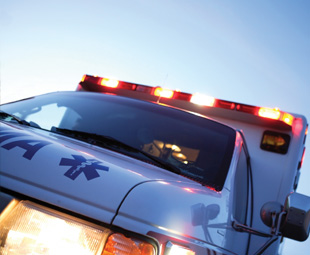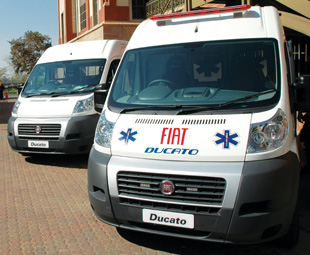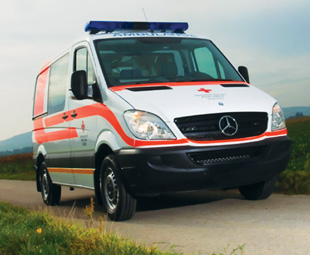Make way for the sirens

Emergency vehicles form possibly the most important segment of the market, frequently meaning the difference between life and death. JACO DE KLERK discovers that constant refinements are being made to tip the balance in favour of those who need help, while enhancing the safety, comfort and efficiency of those who provide it.
The emergency vehicle industry is of vital importance to everyone, and the South African population keeps growing, placing massive demands on emergency medical services. According to Shalen Ramduth, Netcare 911 head of national road operations, private providers of emergency medical services will continue to play a vital role within the South African healthcare sector.
Standardising the fleet
Safety is paramount to Netcare 911, and is one of the reasons South Africa’s foremost provider of emergency medical services decided, in May 2009, to standardise its ambulance fleet using the Volkswagen T5. The T5 replaced the larger Volkswagen Crafter 35 in the Netcare 911 ambulance fleet, largely due to its better road handling. International trends are also moving towards less cumbersome vehicles, which are more manoeuvrable and can negotiate their way through heavy traffic more easily.
 Bohdan de Wet, national after sales service manager of commercial vehicles at Volkswagen South Africa, says the T5 comes in numerous configurations, which reduces costs when converting it to an ambulance. Even more importantly, it offers excellent occupant safety. In addition, the vehicles are all fuel efficient when compared to other vehicles within their respective classes and leave a relatively minimal carbon footprint.
Bohdan de Wet, national after sales service manager of commercial vehicles at Volkswagen South Africa, says the T5 comes in numerous configurations, which reduces costs when converting it to an ambulance. Even more importantly, it offers excellent occupant safety. In addition, the vehicles are all fuel efficient when compared to other vehicles within their respective classes and leave a relatively minimal carbon footprint.
Standardising the interior
The adoption of the Volkswagen T5 at Netcare 911 was followed soon after by the standardisation of the interiors of the ambulances. While Volkswagen provides the vehicles to Netcare 911, it does not convert them into ambulances. This task is instead undertaken by a specialised service provider.
Netcare 911’s conversion to the Volkswagen T5 provided the company with the opportunity to redesign the interiors of all of its ambulances to a set standard – a process that commenced late in 2010.
According to Deon Myburgh, national fleet manager at Netcare 911, the objectives of the Emergency Ambulance Conversion Project were as follows:
• To improve crew safety, especially for those treating the patient in the cabin;
• To improve patient safety when in transit, whether seated or lying on the stretcher;
• To ensure the best possible equipment placement within the ambulance while paying attention to the secure and safe storage of equipment;
• To achieve the most ergonomic layout possible for the treating crew while making the best possible use of internal space and furniture; and
• To improve infection control within the ambulance.
 “Netcare 911 asked three contractors to develop the ambulance interior with a view to evaluating them and selecting the best possible design,” says Myburgh. “Our specifications were quite demanding, but we selected a leading ambulance designer to fulfil our contracts due to it being registered with the Department of Transport, which was an important consideration for us. The results speak for themselves and I believe that we have one of the most efficient ambulance interiors in our sector.”
“Netcare 911 asked three contractors to develop the ambulance interior with a view to evaluating them and selecting the best possible design,” says Myburgh. “Our specifications were quite demanding, but we selected a leading ambulance designer to fulfil our contracts due to it being registered with the Department of Transport, which was an important consideration for us. The results speak for themselves and I believe that we have one of the most efficient ambulance interiors in our sector.”
Ambulances larger than the Volkswagen T5 have benefits of their own – offering enhanced crew comfort, increased storage capacity, more working space, and greater layout and design flexibility.
One vehicle that combines the benefits of a larger ambulance with the convenience of being able to drive it with a Code EB driver’s licence is Fiat’s Ducato, which recently started with this new venture. “There are three main reasons for its suitability for conversion to an ambulance,” says Richard Sloman, media relations manager of Chrysler South Africa (Fiat and Chrysler have formed a global strategic alliance).
“It has a low loading threshold compared to many other vans in the same category, making loading a patient on a stretcher into the ambulance both safer and easier to do,” he explains. “It is also a code 8 vehicle, which means that anyone with an EB driver’s licence is able to drive it – one of the main reasons we noticed and saw the opportunity to convert it into an ambulance.”
 A third party that performs the conversions played an integral part in the realisation of this project for the Ducato. “The opportunity was discovered in collaboration with Bustruck, with whom we have a long-standing relationship on conversions,” says Sloman.
A third party that performs the conversions played an integral part in the realisation of this project for the Ducato. “The opportunity was discovered in collaboration with Bustruck, with whom we have a long-standing relationship on conversions,” says Sloman.
He adds that the Ducato offers outstanding running cost advantages thanks to its economical diesel engine and 45 000 km service intervals. And with the requirements of these converted vehicles varying from customer to customer, the company offers tailored maintenance service packages.
“Ambulances today are a far cry from what they were just a few years ago,” says Myburgh. “Today we are putting fully equipped intensive care units on the road. This is good news for South Africans who rely on providers of emergency medical services to care for them in the event of a medical emergency.”
Published by
Focus on Transport
focusmagsa




